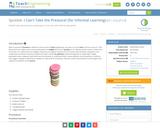
Students learn about pressure, employing it to crush cans and model the atmosphere.
- Subject:
- Education
- Material Type:
- Lesson Plan
- Provider:
- TeachEngineering
- Provider Set:
- TeachEngineering
- Date Added:
- 10/14/2015

Students learn about pressure, employing it to crush cans and model the atmosphere.

Students develop their understanding of the effects of invisible air pollutants with a rubber band air test, a bean plant experiment and by exploring engineering roles related to air pollution. In an associated literacy activity, students develop visual literacy and write photograph captions. They learn how images are manipulated for a powerful effect and how a photograph can make the invisible (such as pollutants) visible. Note: You may want to set up the activities for Air Pollution unit, Lessons 2 and 3, simultaneously as they require extended data collection time and can share collection sites.
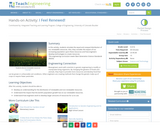
In this activity, students will simulate the equal and unequal distribution of our renewable resources. Also, they will consider the impact of our increasing population upon these resources and how engineers develop technologies to create resources.
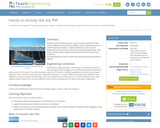
Students examine how the power output of a photovoltaic (PV) solar panel is affected by temperature changes. Using a 100-watt lamp and a small PV panel connected to a digital multimeter, teams vary the temperature of the panel and record the resulting voltage output. They plot the panel's power output and calculate the panel's temperature coefficient.
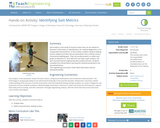
Gait analysis is the study of human motion that can be utilized as biometric information or identification, for medical diagnostics or for comparative biomechanics. In this activity, students observe walking human subjects and then discuss parameters that could be used to characterize walking gaits. They use accelerometers to collect and graph acceleration vs. time data that can help in gait analysisâall part of practicing the engineering data analysis process. Students complete this activity before learning the material presented in the associated lesson.
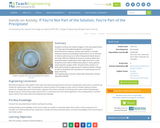
Students continue the research begun in the associated lesson as if they were biomedical engineers working for a pharmaceutical company. Groups each perform a simple chemical reaction (to precipitate solid calcium out of solution) to observe what may occur when Osteopontin levels drop in the body. With this additional research, students determine potential health complications that might arise from a new drug that could reduce inflammatory pain in many patients, improving their quality of life. The goal of this activity is to illustrate biomedical engineering as medical problem solving, as well as emphasize the importance of maintaining normal body chemistry.

In this role-playing activity, students learn how cellular phone service works, its advantages and its limitations. Students also learn about the advantages and limitations of satellite phone service. Phone communication involves many aspects of science, math and engineering, and this activity conveys to students how these technologies help people to stay better connected. Students use what they learn to understand what communication options might be available for Maya and her parents, Spacewoman Tess and Spaceman Rohan.
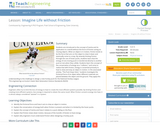
Students are introduced to the concept of inertia and its application to a world without the force of friction acting on moving objects. When an object is in motion, friction tends to be the force that acts on this object to slow it down and eventually come to a stop. By severely limiting friction through the use of the hover pucks, students learn that the energy of one moving puck is transferred directly to another puck at rest when they collide. Students learn the concept of the conservation of energy via a "collision," and will realize that with friction, energy is converted primarily to heat to slow and stop an object in motion. In the associated activity, "The Puck Stops Here," students will investigate the frictional force of an object when different materials are placed between the object and the ground. This understanding will be used to design a new hockey puck for the National Hockey League.
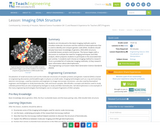
Students are introduced to the latest imaging methods used to visualize molecular structures and the method of electrophoresis that is used to identify and compare genetic code (DNA). Students should already have basic knowledge of genetics, DNA (DNA structure, nucleotide bases), proteins and enzymes. The lesson begins with a discussion to motivate the need for imaging techniques and DNA analysis, which prepares students to participate in the associated two-part activity: 1) students each choose an imaging method to research (from a provided list of molecular imaging methods), 2) they research basic information about electrophoresis.
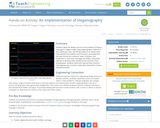
Students apply the design process to the problem of hiding a message in a digital image using steganographic methods, a PictureEdit Java class, and API (provided as an attachment). They identify the problems and limitations associated with this task, brainstorm solutions, select a solution, and implement it. Once their messages are hidden, classmates attempt to decipher them. Based on the outcome of the testing phase, students refine and improve their solutions.
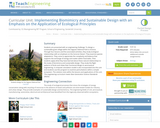
Students are presented with an engineering challenge: To design a sustainable guest village within the Saguaro National Park in Arizona. Through four lessons and six associated activities, they study ecological relationships with an emphasis on the Sonoran Desert. They examine species adaptations. They come to appreciate the complexity and balance that supports the exchange of energy and matter within food webs. Then students apply what they have learned about these natural relationships to the study of biomimicry and sustainable design. They study the flight patterns of birds and relate their functional design to aeronautical engineering. A computer simulation model is also incorporated into this unit and students use this program to examine perturbations within a simple ecosystem. The solution rests within the lessons and applications of this unit.
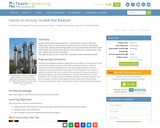
Students learn about material balances, a fundamental concept of chemical engineering. They use stoichiometry to predict the mass of carbon dioxide that escapes after reacting measured quantities of sodium bicarbonate with dilute acetic acid. Students then produce the reactions of the chemicals in a small reactor made from a plastic water bottle and balloon.
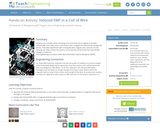
Students use a simple set up consisting of a coil of wire and a magnet to visualize induced EMF. First, students move a coil of wire near a magnet and observe the voltage that results. They then experiment with moving the wire, magnet, and a second, current carrying coil. Students connect the coil to a circuit and the current from the induced EMF charges a conductor.
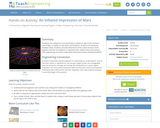
Students use scaling from real-world data to obtain an idea of the immense size of Mars in relation to the Earth and the Moon, as well as the distances between them. Students calculate dimensions of the scaled versions of the planets, and then use balloons to represent their relative sizes and locations.
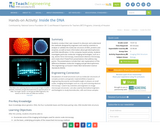
Students conduct their own research to discover and understand the methods designed by engineers and used by scientists to analyze or validate the molecular structure of DNA, proteins and enzymes, as well as basic information about gel electrophoresis and DNA identification. In this computer-based activity, students investigate particular molecular imaging technologies, such as x-ray, atomic force microscopy, transmission electron microscopy, and create short PowerPoint presentations that address key points. The presentations include their own explanations of the difference between molecular imaging and gel electrophoresis.
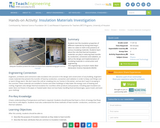
Students test the insulation properties of different materials by timing how long it takes ice cubes to melt in the presence of various insulating materials. Students learn about the role that thermal insulation materials can play in reducing heat transfer by conduction, convection and radiation, as well as the design and implementation of insulating materials in construction and engineering.
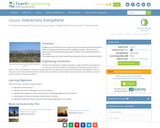
Students are introduced to the concept of an environment and the interactions within it through written and hands-on webbing activities. They also learn about environmental engineering careers and the roles of these engineers in our society.

While building and testing model rockets fueled by antacid tablets, students are introduced to the basic physics concepts on how rockets work. Students revise and improve their initial designs. Note: This activity is similar to the elementary-level film canister rockets activity, but adapted for middle school students.

After watching a 1940 film clip of the "Galloping Gertie" bridge collapse and a teacher demo with a simple pendulum, student groups discuss and then research the idea of motion that repeats itself specifically the concepts of periodic and harmonic motion. They become aware of where and how these types of motion occur and affect them in everyday applications, both natural (seasons, tides, waves) and engineered (swings, clocks, mechanical systems). They learn the basic properties of this type of motion (period, amplitude, frequency) and how the rearrangement of the simple pendulum equation can be used to solve for gravitational acceleration, pendulum length and gravity. At lesson end, students are ready to conduct the associated activity during which they conduct experiments that utilize swinging Android® devices as pendulums.
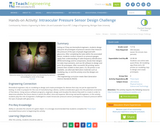
Acting as if they are biomedical engineers, students design and print 3D prototypes of pressure sensors that measure the pressure of the eyes of people diagnosed with glaucoma. After completing the tasks within the associated lesson, students conduct research on pressure gauges, apply their understanding of radio-frequency identification (RFID) technology and its components, iterate their designs to make improvements, and use 3D software to design and print 3D prototypes. After successful 3D printing, teams present their models to their peers. If a 3D printer is not available, use alternate fabrication materials such as modeling clay, or end the activity once the designs are complete.